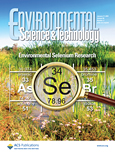Environmental Science and Technology 46(2)
Overview of new articles on POPs in a new issue of the Environmental Science & Technology journal.
Selected articles
Deposition of Brominated Flame Retardants to the Devon Ice Cap, Nunavut, Canada
Torsten Meyer, Derek C. G. Muir, Camilla Teixeira, Xiaowa Wang, Teresa Young, and Frank Wania
pp 826–833
- Brominated flame retardants (BFRs) can be transported to Arctic regions via atmospheric long-range transport, however, relatively little is known about their deposition to terrestrial environments. Snow cores from the Devon Ice Cap in Nunavut, Canada served to determine the recent depositional trends of BFRs. Snow pits were dug in 2005, 2006, and 2008. Dating using annual snow accumulation data, ion chemistry, and density measurements established that the pits covered the period from approximately 1993 to spring 2008.
Fluxes of Polychlorinated Biphenyls Volatilizing from the Hudson River, New York Measured Using Micrometeorological Approaches
Andy L. Sandy, Jia Guo, Robert J. Miskewitz, Wade R. McGillis, and Lisa A. Rodenburg
pp 885–891
- This study represents the first time that a micrometeorological technique, using turbulent transport measurements, has been used to determine the direction and magnitude of air–water exchange of polychlorinated biphenyls (PCBs). The study was conducted during July 2008 on the Hudson River estuary near the Tappan Zee Bridge, which is the site of some of the most serious PCB contamination in the world.
Near-Real-Time Combustion Monitoring for PCDD/PCDF Indicators by GC-REMPI-TOFMS
Brian K. Gullett, Lukas Oudejans, Dennis Tabor, Abderrahmane Touati, and Shawn Ryan
pp 923–928
- The boiler exit flue gas of a municipal waste combustor was sampled to evaluate an online monitoring system for chlorobenzene congeners as indicators of polychlorinated dibenzodioxin and dibenzofuran (PCDD/PCDF) concentrations. Continuous measurements of chlorobenzene congeners using gas chromatography coupled to a resonance-enhanced multiphoton ionization - time-of-flight mass spectrometry (GC-REMPI-TOFMS) system were compared over 5-min periods with conventional sampling methods for PCDD/PCDF.
Does Equilibrium Passive Sampling Reflect Actual in Situ Bioaccumulation of PAHs and Petroleum Hydrocarbon Mixtures in Aquatic Worms?
Barry Muijs and Michiel T. O. Jonker
pp 937–944
- The present study investigated whether bioaccumulation of PAH and complex petroleum hydrocarbon mixtures in field-exposed aquatic worms could be predicted properly with passive samplers. To this end, in situ bioaccumulation in aquatic worms at 6 PAH-contaminated locations and 8 petroleum hydrocarbon (oil)-contaminated locations was compared with the results of in situ solid phase micro extraction (SPME) applications.
Passive Samplers Provide a Better Prediction of PAH Bioaccumulation in Earthworms and Plant Roots than Exhaustive, Mild Solvent, and Cyclodextrin Extractions
Jose L. Gomez-Eyles, Michiel T. O. Jonker, Mark E. Hodson, and Chris D. Collins
pp 962–969
- In this study, PAH bioavailability was assessed in ten field-contaminated soils by using exhaustive acetone/hexane extractions, mild solvent (butanol) extractions, cyclodextrin extractions, and two passive sampling methods; solid phase micro extraction (SPME) and polyoxymethylene solid phase extraction (POM-SPE). Results were compared to actual PAH bioaccumulation in earthworms (Eisenia fetida) and rye grass (Lolium multiflorum) roots.
Effectiveness of Activated Carbon and Biochar in Reducing the Availability of Polychlorinated Dibenzo-p-dioxins/Dibenzofurans in Soils
Yunzhou Chai, Rebecca J. Currie, John W. Davis, Michael Wilken, Greg D. Martin, Vyacheslav N. Fishman, and Upal Ghosh
pp 1035–1043
- Five activated carbons (ACs) and two biochars were tested as amendments to reduce the availability of aged polychlorinated dibenzo-p-dioxin/dibenzofurans (PCDD/Fs) in two soils. All sorbents (ACs and biochars) tested substantially reduced the availability of PCDD/Fs measured by polyoxymethylene (POM) passive uptake and earthworm (E. fetida) biouptake.
Impact of Dust from Multiple Microenvironments and Diet on PentaBDE Body Burden
Deborah J. Watkins, Michael D. McClean, Alicia J. Fraser, Janice Weinberg, Heather M. Stapleton, Andreas Sjödin, and Thomas F. Webster
pp 1192–1200
- Our objectives were to determine relative contributions of diet and dust exposure from multiple microenvironments to PentaBDE body burden, and to explore the role of handwipes as a measure of personal exposure to PentaBDE. We administered a food frequency questionnaire and collected serum, dust (office, main living area, bedroom, and vehicle), and handwipe samples from 31 participants.
19.1.2012





